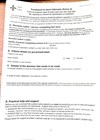The NHS and urology face challenging times in trying to provide quality patient care efficiently and economically. Urology trainees are experiencing conflicting pressures with a new contract, a challenging on-call system and changing training requirements in an overstretched, centralised service serving a modern society. The last few years have seen tensions between junior doctors and their trade union, governing body and the Department of Health. Challenges lie ahead both before and after completion of CCT.
The recent cases of Bawa-Garba and Sellu have shown the need to ensure that patient care is optimised, while maintaining the support and legal position of healthcare professionals. Patient care and training should take place in a safe and supportive environment for all involved.
“A more patient-centred process is now required with the emphasis on individualised understanding of the risks of a treatment, compared to the alternatives, and no treatment at all.”
Most trainees spend the day getting through clinics, on-calls and theatre lists while planning and reflecting on their training. Other than knowledge, ability, health and resilience are there any other threats to the progression through specialist training? Some of the legal challenges to life as a trainee are discussed with advice or caution emphasised as appropriate.
Consent after Montgomery
Urology trainees will often be involved in the consent process. This may include counselling patients in clinic or taking written consent prior to surgery. The mindset around consent has changed since the Montgomery ruling [1]. A more patient-centred process is now required with the emphasis on individualised understanding of the risks of a treatment, compared to the alternatives, and no treatment at all. A signed consent form does not prove the patient has full understanding of their options and consent should be viewed as a continuous (or evolving) process rather than occurring at one specific point in time. A patient needs time and active involvement in the decision-making process. The relevant risks are perhaps different to those that may have been traditionally discussed in the consent process.
As well as the Montgomery ruling, subsequent cases make interesting reading [2]. In the case of Spencer vs. Hillingdon Hospital (2015) the claimant developed bilateral pulmonary emboli following inguinal hernia repair. The court found that the defendant trust had failed to explain this risk to the patient. Such rulings surely highlight the need to modify our personal consenting practices and perhaps the content of procedure-specific consent forms.
The Royal College of Surgeons has set out guidelines on consent following the Supreme Court ruling [3]. The aim of the discussion is to give the patient the individually tailored information they need to make a decision about their treatment, with all reasonable options along with their implications explained to the patient. Material risks need discussing with the patient. That is those that “a reasonable person in the patient’s position would be likely to attach significance to the risk, or the doctor is or should reasonably be aware that the particular patient would likely attach significance to it” [3]. Consent should be written and recorded. The process should take place in advance rather than on the day of surgery. Duffy, a barrister in clinical negligence, gives 10 tips for staying out of trouble when consenting [4] (Figure 1).
Figure 1. Consent after Montgomery [4]:
- Make full notes
- Discuss reasonable alternatives
- Ensure adequate time is set aside
- Focus on the individual patient
- Engage in a genuine two-way dialogue
- Do not simply focus on percentages
- Consider the risk of intervening events, not just catastrophic outcomes
- Think very carefully before relying on the therapeutic exception
- Patient understanding
- Leafleting is not enough
In addition to completing the consent form, surgeons should maintain a written decision-making record containing the key points of the discussion, and the patient’s decision. It is specified that time pressures do not change the fundamental legal requirement that surgeons and doctors allocate sufficient time for discussion: “…even those doctors who have less skill or inclination for communication, or are more hurried, are obliged to pause and engage in the discussion which the law requires” [1].
Most surgeons may find the current working environment makes this standard hard to deliver. If coming short every surgeon and their trainee are exposing themselves to risk of subsequent litigation. Individuals can modify their practice and approach to patients but departmental and / or trust support is needed to make these standards realistic rather than aspirational. The directive for this is the Supreme Court after all.
Litigation
Medico-legal claims against NHS organisations have increased over the last 30 years, with significant financial impact [5]. A successful claim requires the patient to show that they were owed a duty of care, the duty was breached causing damage and that there was loss as a consequence [6]. A 2011 review of litigation in urology revealed 493 cases closed with indemnity payment with a total of £20,508,686 [7]. The average payment per claim was £41,599.77. Most claims were related to non-operative events (232), followed by postoperative events (168) and intraoperative events (92). The most common reasons were failure to diagnose or treat cancer (69), perforation or injury to an organ and forgotten ureteric stent, respectively [7]. The authors emphasised the importance of thorough clinical assessment, record-keeping and follow-up as well as informed consent and good communication with patients.
To put these findings in context a previous estimate was that just 2% of NHS-wide claims are successful [8] and a wider review of surgical litigation showed urology had less claims than most of the other surgical specialties [5]. Litigation associated with surgery accounts for 40% of all clinical negligence claims in England [8]. The question many will have is where is the line between an accepted complication and negligence? And who makes that decision? Michael Bishop, following the Osmond and Collins publication, called for documentation of medico-legal work undertaken by urological ‘experts’ and a move to expert panels providing guidance on litigation rather than medical witnesses taking opposing views [9]. Ford and Cooper called for litigation information to be scrutinised to allow improvements to stop repeat events [5].
“A balance is needed between ensuring patient safety and promoting shared learning from adverse events and medical errors.”
Good knowledge, training and communication will help reduce risk for urology trainees. Many complaints and claims will relate to system and process, rather than individual, errors. Trainees are encouraged to take part in Quality Improvement (QI) projects to enhance patient safety. The challenge is contributing to important and sustained improvements rather than pure tick-box exercises. BAUS has acknowledged the importance of QI with sessions and training available at its annual conference. Formal training would empower trainees and their consultants to lead meaningful change.
Negligence and its criminalisation
The point at which a medical error becomes a criminal act is contentious and has been brought into the media by the January Bawa-Garba ruling [10]. Urologists are aware of potential prosecution following the custodial sentence given to a consultant urologist after a guilty plea of gross negligence manslaughter [11]. The basis of the charge was a delay in nephrostomy for a 37-year-old with infected obstructed kidney over an August bank holiday weekend, and subsequent alteration of the medical records. In 2015 Edwards described another five cases of medical manslaughter between 2003 and 2013 [11]. There were 22 convictions before this dating back to 1795 [12].
Recent convictions generally relate to errors or failure to treat by the individual. The Bawa-Garba case was different with the public details of the case suggesting an over-worked, understaffed NHS with deficiencies in induction, IT and support for doctors. There were multiple people involved including the responsible consultant, nursing staff, Bawa-Garba and the trust. Bawa-Garba and nurse Amaro were convicted. The General Medical Council (GMC) appealed their own tribunal to ensure the doctor with this conviction would be removed from their Register.
The actions of the GMC remain under protest and parliamentary enquiry. However, once a verdict of manslaughter is returned, it seems difficult to imagine a full return to work. When medical errors do occur thoughts immediately go to the patient and their families. They also impact on the emotional wellbeing, quality of life and professional practice of the medical staff [13,14]. How the average trainee would manage after being involved in a medical error is of concern with 61% already reporting significant stress, and half feeling ill due to work-related stress, without this additional burden. [15].
Such cases remind us of the pillars of Good Medical Practice [16]. Positive developments include the BAUS national audits aiming at optimising standards. Trainees may be wondering whether they are exposing themselves to risk when attending work. There is individual risk of making an error in the outpatient clinic, operating theatre or during the emergency assessment of a patient. The consequences may depend on the supervision at the time and the impact, and its longevity, on the patient. There is also risk related to the work environment. How many can say they have worked without an induction, with understaffing, IT problems or without the support there ideally should be? In the light of this case what should trainees do if put in this position? Is working as hard as you can to give patient care in adverse conditions the right thing to do?
A British Medical Association (BMA) survey last year showed that 65% of hospital doctors reported vacancies in their departments [17]. Seven hundred and forty-seven trainees reported patient safety concerns through the GMC national survey in 2017 [18]. How an individual or department best responds to these vacancies is not clear. Colleagues ‘acting-up’ or ‘acting-down’ can cause a dangerous increase in workload and may have implications for service provision and training. The use of locums can provide temporary relief at some cost however their quality, experience and training need to be assured. Locum-caps mean that vacancies are sometimes not filled. The trust, or department would be responsible for errors made by a locum with inadequate experience.
There needs to be an opportunity to learn from adverse events. Five percent of trainees felt that patient safety concerns are not dealt with effectively in the GMC national survey [18]. The Bawa-Garba case has precipitated “really genuine anxieties within the medical profession about reflection and about raising concerns and about a culture of learning,” Charlie Massey, the GMC Chief Executive, has admitted [19]. If reflective practice is used as evidence during litigation it will make doctors more reluctant to share their errors and limit the learning that can come from them. Official guidance on reflection is due to be published by the BMA and GMC in the summer. The Academy of Medical Royal Colleges’ guidance on improving feedback suggests that anonymised reflections should focus on learning rather that what has gone wrong, and should not contain anything that the patient is unaware of [20]. The GMC will not ask to see reflective statements as part of an investigation but a court could order their production if considered relevant.
Raising concerns
How should, and would, trainees respond to patient safety concerns? All doctors need to be familiar with reporting processes such as Datix, root cause analysis, serious incidents, and never events. Ongoing concerns can be escalated to supervisors, clinical directors, medical directors and programme directors until the safety of a patient is ensured. However, those familiar with the whistleblowing case of Dr Chris Day may have second thoughts. Having raised concerns about overnight staffing levels on an intensive care unit in South East London he found himself out of a career. The Court of Appeal has found that the legal argument advanced on behalf of Health Education England to be flawed. The case is going back to tribunal after four years. The BMA, Royal Colleges and Department of Health surely need to ensure that any doctor feels safe to raise concerns that will protect their patients.
The future
Challenges remain for urology trainees and the wider profession. A balance is needed between ensuring patient safety and promoting shared learning from adverse events and medical errors. Lord Justice Jackson in a Court of Appeal judgment stated: “Even good and conscientious doctors may, from time to time, fall short. That is not a reason to lose heart or (even worse) to abandon medical practice. Those who have learnt from past mistakes often have even more to offer.” [22].
Reflection and the opportunity for shared learning from medical errors need to be protected. Following the reversal of restrictions on David Sellu after his wrongful conviction of gross negligence manslaughter the Royal College of Surgeons called for clarification and reform of the application of manslaughter by gross negligence [23].
Trainees would benefit from undergraduate and postgraduate education in legal awareness and quality improvement to maximise and protect their careers. All trainees and consultants should feel able to raise concerns about patient care in the urology community.
There are now training bodies for most of the major surgical specialties and campaigns such as ‘Hammer it out’ from the British Orthopaedic Trainees Association (BOTA) have demonstrated the power that a combined voice can have for improving the working conditions for trainees. SURG, the BAUS section for trainees, aims for greater collaboration with other training bodies, the BMA, Royal College of Surgeons and the GMC in trying to promote and protect trainee interests in the coming years, enabling us to deliver the best care possible for our patients.
In summary, risks can be managed by being aware, taking time to discuss consent and carefully recording patient interactions. All urologists make important diagnostic and treatment decisions or recommendations on a daily basis. Many of these entail risk for the patient, but also the doctor. Continuing support is needed from hospital management, the Royal College of Surgeons and BAUS to manage this risk. Modernisation of clinical approach and service organisation, for example protected time for consent is needed to deliver safe care to a modern society
References
1. Montgomery (Appellant) v Lanarkshire Health Board (Respondent). 2015 UKSC 11 On appeal from 2013 CSIH 3; [2010] CSIH 104.
2. Chan S, Tulloch E, Cooper S, et al. Montgomery and informed consent: where are we now? BMJ 2017;357:J2224.
3. RCS. Consent: Supported Decision Making. A Guide to Good Practice. 2016.
www.rcseng.ac.uk
4. Duffy J. Informed consent: a year on from Montgomery. MDU Journal; 2016.
https://mdujournal.themdu.com
/issue-archive/
issue-4/informed-consent
-a-year-on-from-montgomery
5. Ford KE, Cooper LRL. Learning from lawsuits: ten years of NHS litigation authority claims against surgical specialties in England. The Surgeon 2018;16:27-35.
6. Goldenberg SD, Volpe H, French GL. Clinical negligence, litigation and healthcare-associated infections. J Hosp Infect 2012;81:156-62.
7. Osman NI, Collins GN. Urological litigation in the UK National Health Service (NHS): an analysis of 14 years of successful claims. BJU Int 2011;108:162-5.
8. Alkhaffaf B, Decadt B. Litigation following groin hernia repair in England. Hernia 2010;14:181-6.
9. Bishop M. Urological Litigation. BJUI 2011;1089(11):1680-82.
10. General Medical Council v Dr Bawa-Garba. [2018] EWHC 76 (Admin).
11. Edwards S. Medical manslaughter a recent history. Bulletin 2015;96(4):118-19.
12. Ferner RE, McDowell SE. Doctors charged with manslaughter in the course of medical practice, 1795–2005: A literature review. J R Soc Med 2006;99:309-14.
13. Elwahab SA, Doherty E. What about doctors? The impact of medical errors. The Surgeon 2014;12(6):297-300.
14. Waterman AD, Garbutt J, Hazel E, et al. The emotional impact of medical errors on practicing physicians in the United States and Canada. Jt Comm J Qual Patient Saf. 2007;33:467-76.
15. BMA. Working in a system that is under pressure. 2018.
www.bma.org.uk/collective-voice/influence/
key-negotiations/nhs-pressures/
working-in-a-system-under-pressure
16. GMC. Good Medical Practice. 2013.
www.gmc-uk.org
17. BMA Quarterly Survey: Current views from across the medical profession. 2017.
www.bma.org.uk
18. GMC National Training Survey. 2017.
www.gmc-uk.org/education/
national_summary_reports.asp
19. Cooper K. GMC hits low ebb. 2018.
www.bma.org.uk
20. Academy of Royal Medical Colleges. Guidance on entering information onto e-portfolios. 2016.
www.aomrc.org.uk
21. FB v Princess Alexandra Hospital NHS Trust. [2017] EWCA Civ 334
22. Royal College of Surgeons of England. RCS comment on David Sellu ruling. 2018.
www.rcseng.ac.uk
SURG – The BAUS Section for Urology Trainees
Represents interests of urology trainees locally, regionally and nationally. Information, training and research opportunities and contact details can be found at www.baus.org.uk/professionals/surg/default.aspx
Acknowledgement:
The authors would like to acknowledge the support and involvement of the SURG Committee.










